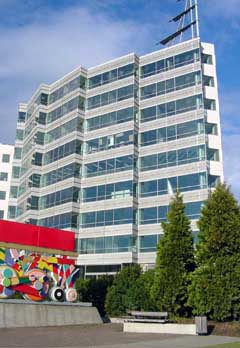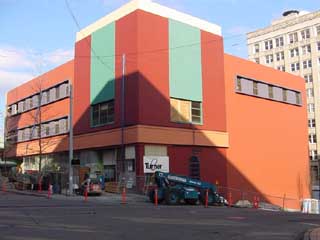
Marketplace
Surveys
DJC.COM
February 22, 2001
Hopes run high for Tacoma’s future
Special to the Journal
How times have changed to put Tacoma on the fast track.

|
More than a decade ago, catching a whiff of opportunity in downtown Tacoma, German billionaire Erivan Haub purchased the nondescript Greyhound bus terminal fronting Pacific Avenue. Haub repeatedly tried to acquire a U.S. Postal Service parking lot next to the aging, low-profile station to create a “superblock” on which to build, but the owner rebuffed every offer.
Lucky for Tacoma.
As negotiations on the Postal Service lot fizzled, a former Key Bank building went on the market nearby. Not only was the site on A Street, a main downtown street that already included the Frank Russell and Weyerhaeuser buildings, but it sat perched above the Thea Foss Waterway and a sweeping vista of the waterfront. Haub first considered refurbishing the bank structure, but when Columbia Bank and then Frank Russell both expressed interest in a more permanent arrangement, the developer broadened his dream.
That dream, the 9-story, 190,000-square-foot Columbia Bank Center, will be unveiled today at an open house. Anchor tenants Columbia Bank, which will establish its headquarters there, and Frank Russell Co. will occupy the building in March and April. About 40,000 square feet of prime office and retail space will be available for other tenants.
Haub’s glassy, prow-shaped wedge signals the awakening of new construction in the once-dormant downtown, where a dozen redevelopment projects are already underway and a regional convention center, two museums, office complexes and a waterfront hotel are under construction or planned.
“There’s a great sense of accomplishment in being involved in a project of this scale because of its impact on the community,” said the Neil Walter Co.’s Mike Hickey, leasing agent for Columbia Bank Center.
“It helps to validate the overall commercial viability of our downtown core. It’s not necessarily a launching pad for more new buildings, but it shows the community’s receptiveness to that type of project.”
And how. Tacoma’s receptiveness has brought in $687 million in public and private developments recently completed or “in the pipeline,” said Juli Wilkerson, director of the city of Tacoma’s economic development department.
Projects where construction cranes have already spread their wings include:
• Labor Ready headquarters in the upgraded and redesigned 10-story, 120,000-square-foot former Weyerhaeuser Building, which the temporary staffing company will occupy this spring.
• KeyCenter, the radical makeover of the 100,000-square-foot former Peoples store to house Key Bank’s downtown Tacoma offices and services.
• Horizon Pacific Center, three contiguous historic buildings renovated by Oakland, Calif., developers Horizon Partners Inc. and Tacoma’s Rushforth Construction Co. and featuring more than 150,000 square feet of flexible space with high-tech amenities.
• The 8-story Perkins Building, a $7 million refurbishment where telecommunications provider Optic Fusion recently absorbed the bulk of its 68,000 square feet.
• Heritage Bank Plaza, the 90,000-square-foot former Key Bank Tower purchased by private investors Herb Simon and Ted Johnson in June and already nearly 50 percent leased.
• The Woolworth, Kress and Payless buildings, a $15 million renovation of early 1900s structures to create another high-technology complex, with the art deco Woolworth’s 48,000 square feet under negotiations for a full-building tenant.
• The $74 million Museum of Glass and Chihuly Bridge of Glass on the Foss Waterway, scheduled to open in June 2002, and the new $25 million home for the Tacoma Art Museum, set to follow in early 2003.
By early summer, add the much-anticipated Tacoma regional convention center to the list—a project indicative of the Tacoma turnaround and how public investment is helping to heat up the private market.

|
More than triple the size of the current Tacoma Convention Center, the regional facility will include a 50,000-square-foot convention hall, 23,000 square feet of meeting space, a proposed hotel and 76 residential units in what the city’s Wilkerson calls a “co-development plan.”
The idea is for public and private entities to combine forces for redevelopment of a blighted neighborhood or district, she says. When the convention center goes up near 15th and Pacific Avenue—right at the city’s gateway—it will replace abandoned buildings, homeless shelters and a lineup of fading eateries.
Moreover, when it opens in spring 2003, the convention center will extend the cultural and educational district anchored by the University of Washington Tacoma and three regional museums.
A second focal point of public-private development is shaping up along the Thea Foss Waterway. Private investors recently committed $50 million to renovating Totem Marina to create a waterfront housing and shopping area. City officials committed another $4 million for site improvements for the future Foss Waterway Marine.
With the Museum of Glass well under way, the marina deal is a major step forward in converting the former working waterfront into a mixed-use destination combining shops, restaurants, museums, offices, residential space and a public esplanade. More than 500 condominiums, a 100-room European-style hotel and a privately owned motorcycle museum are also planned, with the first phase of development scheduled for completion in 2002.
Convention centers and museums may be the cathedrals of the modern-day skyline, but do they stimulate robust private investment? “No question,” said Bill Frame, senior vice-president for Kidder, Mathews & Segner.
“Those projects draw attention to our community. That brings people downtown into this marketplace to see what’s here,” he said. “You’ll come into downtown next year and you’ll see these nice, new buildings rather than vacant space.”
A more direct public boost like historic preservation incentives and reduced taxes in exchange for workforce training has kept significant private projects alive, he added.
Frame projects a stable Tacoma area market, with vacancy rates remaining steady at 4 percent to 6 percent for Class A space and around 10 percent for Class B. Lease rates should hold at $19 to $23 and $14 to $18.50, respectively, he said.

|
“On A space, we’re gravitating back to $19.50 to $20 a square foot,” Price said. “On B category space, the prices fluctuate widely.”
Consensus in the commercial real estate sector is that redevelopment will continue to star, but it may be a while before another Columbia Bank Center gets built. Frame estimates that developers can still save $4 to $6 on the cost of new construction by choosing to rehab existing space.
Mike Hickey applauds positive factors like good infrastructure, public sector investment, growth from within and the political will to welcome new development. The only thing missing, he said, is a waiting list of companies coming in to serve the Tacoma community—and to take up space.
“It’s an evolution,” said Hickey. “We’re on our way, but it’s going to take a lot more work.”
Dennis Johnson is director of the Media Center for Tacoma and Pierce County.
Other Stories:
- New workplace model: the old town square
- Retailers take to the streets
- Power crisis calls for collective action
- From broker to owner: Craig Schafer tells why he made the switch
- Land is still hot but sales pace cooling
- What’s rental housing’s future? Watch TV
- NW lenders keep the green light on
- Tenant’s lament: should I stay or should I go?
- 10 years of GMA: we’ve only just begun
- Growth management can be good for business
- Why we shouldn’t worry if NW industrial market softens a bit
- NW retail: more bricks and more mortar
- Seattle’s design review: tips for success
- Financing in an uncertain economy
- Office market slowing, but future looks good
- Should technology drive building design?
Copyright ©2009 Seattle Daily Journal and DJC.COM.
Comments? Questions? Contact us.